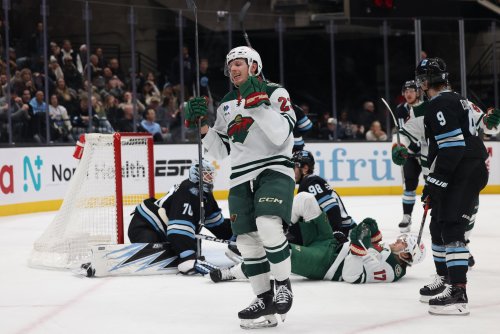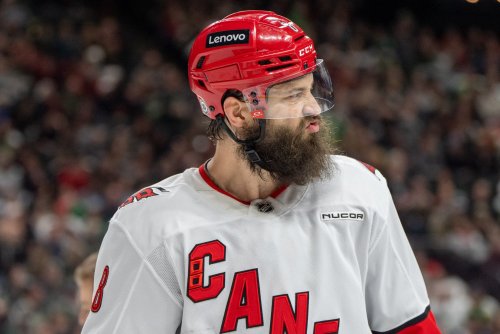
Paul Fenton has been the Minnesota Wild’s general manager for just over a month. But already, we’re starting to see a new direction for the franchise.
While the promised “tweaks” to the NHL roster have yet to come, the front office is undergoing a major shift. Fenton hired Tom Kurvers as the assistant general manager, supplanting Andrew Brunette and Shep Harder in the role.
More significantly, Michael Russo reports that Kurvers will serve as Fenton’s “right-hand man”, overseeing the Iowa Wild and working with professional and amateur scouting. Essentially, Kurvers is also replacing senior vice president Brent Flahr, who served those functions under former general manager Chuck Fletcher. For now, Brunette, Harder, and Flahr are reportedly staying with the Wild.
But despite Fletcher’s top assistants staying in Minnesota, it’s a huge shake-up at the Xcel Energy Center. But beyond the changes at the top of the organization, there was even more movement. In the same report, Russo stated that Fenton parted ways with “a handful” of their amateur scouts.
The names of the scouts, or their responsibilities haven’t been made public. Fenton’s motivation behind the changes hasn’t been reported. We don’t know if this was driven by performance, or if it’s just a matter of a new general manager making space for scouts they know and trust personally.
Regardless, this is a welcome and needed move. Minnesota’s draft strategy is in need of a significant shake-up. And last weekend’s draft provided a clear example of the current scouting department’s flaws.
On Friday night, the Wild made heads turn with their first-round selection. They drafted Filip Johansson at Pick 24. Johansson is known for his intelligence and defensive play. But his offense? Not so much. And in a league where skill from the blue line is at a premium, lacking offensive ability puts a low ceiling on any defenseman drafted.
While the Wild had him high on their draft board, few around the league agreed with Minnesota’s assessment. TSN’s Craig Button had him going almost a full round later, comparing him to defensive defenseman Justin Braun. The scouting publication Future Considerations had him as a third-rounder, despite a glowing review of his play in his zone. The Athletic’s Corey Pronman had perhaps the harshest critique of the pick, stating he would not have recommended drafting him, citing his lack of upside.
By all accounts, Minnesota reached significantly at 24. Granted, we can’t know at this time what Johansson will become. Perhaps Minnesota sees something in him others missed. Maybe Johansson will develop his offensive game and exceed most people’s expectations.
But Johansson’s most likely outcome, should he make the NHL, is a player along the lines of Jonas Brodin. A Top-4 defenseman who provides reliable defense and contributes to the transition game. But one that falls short of making a true impact.
This isn’t to pick on Johansson, or to say that this selection is something like a fireable offense. It’s merely the latest example of Minnesota’s draft tendencies. They play it safe in the early going of the draft, overly valuing two-way players with a “simple” game.
This has burned the team in recent years. In 2014, the Wild selected Alex Tuch and his simple, net-oriented game over the more dynamic David Pastrnak. Tuch was deemed expendable in just 3 years’ time, while Pastrnak became a star in Boston.
In 2015, Minnesota passed over Travis Konecny and Brock Boeser to pick two-way center Joel Eriksson Ek. The speedy, skilled Konecny racked up 47 points for Philadelphia this season, and Boeser has seen his nose for the net translate to the NHL, scoring 33 goals in 72 NHL games. Eriksson Ek remains a very good prospect, but he struggled to score throughout his first full NHL season.
Every team has its fair share of draft misses, and every team can point to instances where they passed on players that went on to be stars. But Minnesota’s strategy seems to leave them open to this. Skill is a precious commodity in the NHL, and the early rounds of the NHL Draft are the easiest, cheapest, and most reliable way to acquire it.
But Minnesota tends to target that later in the draft, after the majority of players with elite skill are picked over. Instead, the Wild’s scouts prioritize two-way ability and size early on, routinely passing on skilled players who may be smaller, or with a defensive game that’s a work-in-progress.
If this seems like this is a long-running issue, that’s because it is. Minnesota has had a pretty stunning amount of continuity in their scouting department, and thus their drafting philosophy.
According to a comparison of the Wild’s team guides, 6 out of 13 amateur scouts have been with the organization since at least the 2008-09 season. That’s almost half the staff that dates all the way back to the Doug Risebrough era. This includes chief amateur scout Guy Lapointe, who has served in that role since the Wild’s inception.
Minnesota has drafted and developed just one 30-goal scorer (Jason Zucker) since Marian Gaborik. And no one on the Wild has scored 70 points since Mikko Koivu.
This isn’t to say that the scouting staff under Fletcher and Flahr has been all bad. In fairness to them, they’ve managed to get NHL players out of most of their first-round picks. From 2010 to 2014, they drafted Mikael Granlund, Brodin, Zack Phillips, Matt Dumba, and Tuch in the first-round. Only Phillips failed to pan out.
It also must be said that the Wild have some very good prospects now. No easy feat with how many top draft picks have been traded by Fletcher in recent years. Kirill Kaprizov is a top-tier prospect. Luke Kunin, Joel Eriksson Ek, and Jordan Greenway are solid bets to be NHL regulars, all with upside.
But there’s a reason a regime change his St. Paul this spring. Try as they might, Fletcher, Flahr, and the Wild’s scouting staff couldn’t find a player with the “it” factor to get them over the hump. Fenton’s immediate concern as GM is to try finding that player via trade or free agency. If he can do that, it’ll bode well for Minnesota in the next 2-3 years.
Long-term success, however, will have to come from identifying those players much earlier on. While many Wild fans and commentators lament that the Wild are shut out from elite players by nature of their draft position, that’s simply not true. Star players are available for the taking, even near the end of the first round.
But Minnesota won’t unearth those stars by being cautious, by aspiring to draft the next Jonas Brodins and Charlie Coyles. They’re going to need to take more home run swings, to bet on skill. Fenton is going to need to overhaul Minnesota’s overall philosophy when it comes to drafting.
Fenton appears to have taken a first step, and undertaking such a dramatic shift in scouting will likely take time and tough conversations. But it is necessary.
Think you could write a story like this? Hockey Wilderness wants you to develop your voice, find an audience, and we'll pay you to do it. Just fill out this form.








Recommended Comments
There are no comments to display.
Join the conversation
You can post now and register later. If you have an account, sign in now to post with your account.
Note: Your post will require moderator approval before it will be visible.